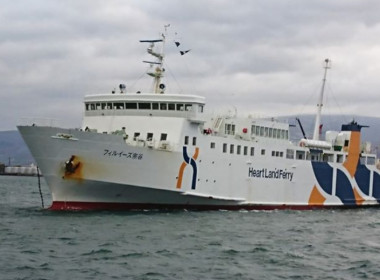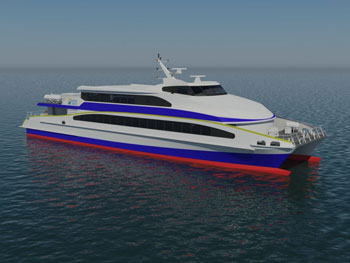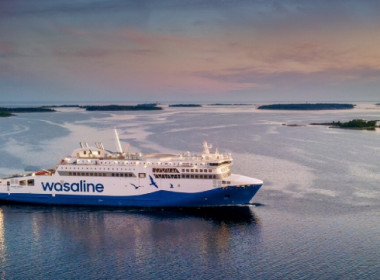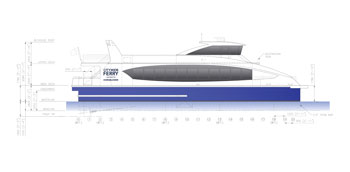VESSEL REVIEW | Aurora Botnia – Wasaline low-emission ferry for Vaasa-Umea service

Finnish ferry operator Wasaline took delivery of its newest Ro-Pax vessel in late August of this year.
Formally named Aurora Botnia, the ferry was handed over by local shipyard Rauma Marine Constructions shortly following the completion of its second series of sea trials. Design work on the vessel was provided by local naval architects Deltamarin.
The vessel will be operated by Wasaline on behalf of Kvarken Link, a Finnish-Swedish consortium that aims to introduce low-emission passenger vessels in the Kvarken region between the Finnish city of Vaasa and the Swedish city of Umeå.
The new ferry has an LOA of 150 metres, a moulded beam of 26 metres, a design draught of 6.1 metres, a gross tonnage of 24,000, and capacity for 800 passengers and 1,500 lane metres of freight on two cargo decks. Construction was carried out in compliance to Finnish Ice Class 1A Super notation as well as SOLAS 2020 and “Stockholm agreement” stability rules.
The vessel’s two-stage, turbocharged dual-fuel main engines are currently powered by LNG but may be modified to be capable of operating on biogas as well. The engines’ manufacturer said that biogas is a totally renewable fuel that can reduce CO2 emissions by up to 90 per cent compared to conventional marine fuels. Also, the fuel emits no particulate matter and close to zero levels of NOx and SOx, ensuring that the vessel exceeds IMO Tier III requirements.
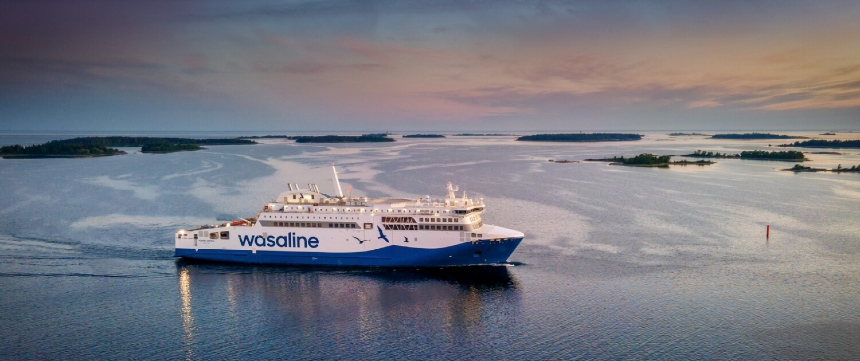
Batteries will meanwhile be used to provide propulsive power to ensure lower emissions when entering or leaving harbours. The batteries will also be utilised for peak shaving, power boost, and hotel load applications. The electric propulsion drive is connected to azimuth thruster units to deliver a speed of 20 knots.
A waste heat recovery system has also been installed to help maximise energy use.
The passengers are housed in 68 cabins. Other facilities include a children’s play area, a conference room, a business lounge, a bar, a cafe, two restaurants, a retail shop, and a lounge for owners traveling with pets. Access is also available for disabled passengers, and all passenger spaces feature intelligent ventilation and lighting.
Instead of lifeboats, a marine evacuation system consisting of chutes has been installed for use in emergencies. This system takes up less space on deck and can be operated by fewer personnel compared to traditional lifeboats. Other pieces of safety equipment include Halton Marine fire and gas dampers, gas-tight shut-off dampers, and non-return dampers.
Aurora Botnia will be operated between Vaasa and Umeå, which both have LNG bunkering facilities and battery charging capability. Wasaline said that although the vessel is not the first ferry to serve this same route, it is nonetheless the first newbuild vessel to be operated between the two cities.
Click here for the other news, features and reviews comprising this month’s Passenger Vessel Week.
| Aurora Botnia | |
| SPECIFICATIONS | |
| Type of vessel: | Ro-Pax ferry |
| Classification: | Finnish Ice Class 1A Super; SOLAS 2020; Stockholm Agreement |
| Flag: | Finland |
| Owner: | Wasaline, Finland |
| Operator: | Wasaline, Finland |
| Designer: | Deltamarin, Finland |
| Builder: | Rauma Marine Constructions, Finland |
| Length overall: | 150 metres |
| Beam: | 26 metres |
| Draught: | 6.1 metres |
| Gross tonnage: | 24,000 |
| Capacity: | 1,500 lane metres |
| Maximum speed: | 20 knots |
| Other equipment installed: | Waste heat recovery system |
| Safety equipment: | Halton Marine dampers; marine evacuation systems |
| Type of fuel: | LNG; battery power; biogas |
| Accommodation: | 68 x cabins; children’s play area; conference room; business lounge; bar; café; restaurants; retail shop; pet lounge |
| Passengers: | 800 |




